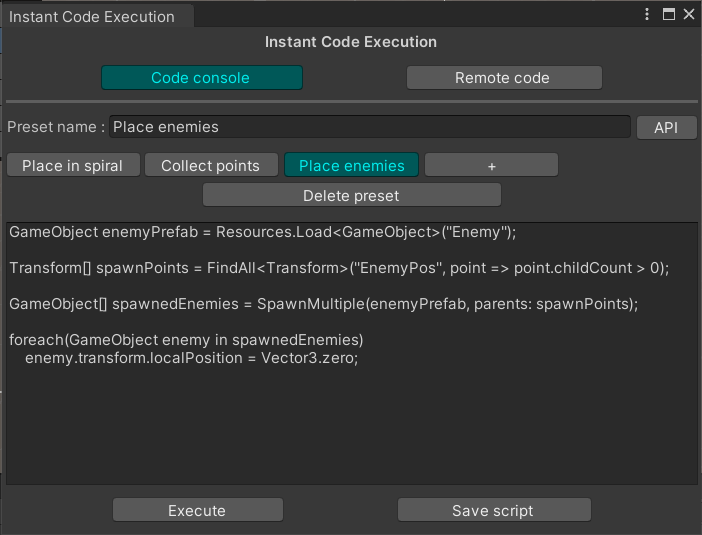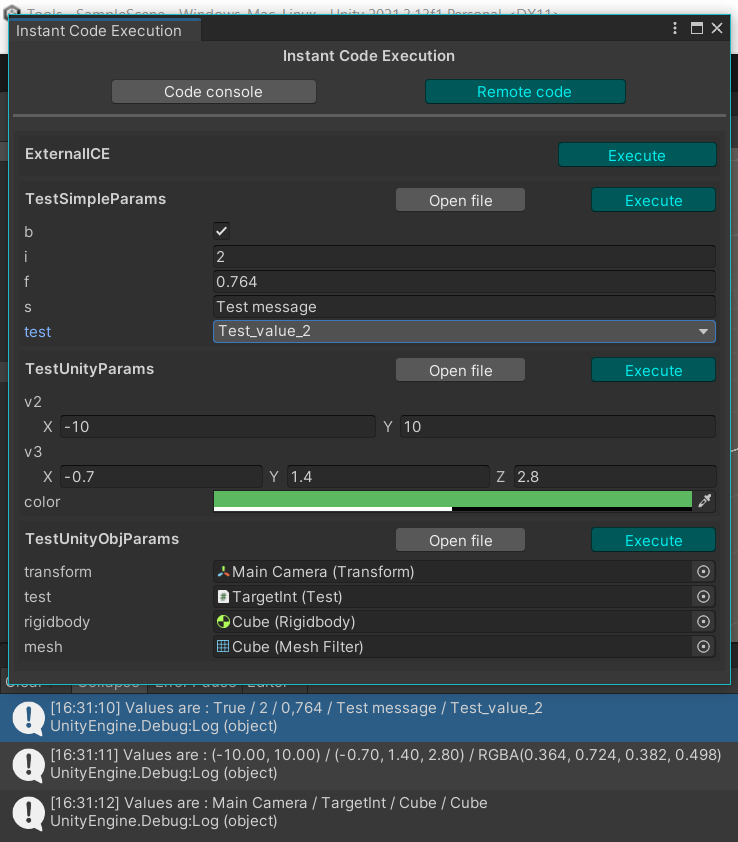This tool is a Unity editor tool.
I.C.E. is a Unity editor tool used to execute code in the editor outside of play mode.
(Yes. This is a Neuromancer reference)
In the Unity Editor, in the top menu bar, under the "Tools" tab you'll find the "ICE" option.
This will open the I.C.E. editor window.
This tool has two panels, the Code console and the Remote code.
The code console panel provides you with a console in which you can directly type your code and a set of presets you can name, save and delete.
The editor code you type is separated into presets you can save, rename and delete using the top section.
Clicking the "+" button will add a new preset.
In the big input box you can type your preset code.
This does not hold any of your IDE/code editor features.
Everytime the code changes it is saved to its preset.
[ESCAPE] key as it would cancel your current changes to your code.
This tool provides the following methods to ease code writing :
Find: Used to find an object in the current scene.FindAll: Used to find mutlitple objects in the current scene.SpawnMultiple: Used to spawn multiple objects in the scene.SpawnMultipleWithPrefabLink: Used to spawn multiple prefabs in the scene and retain the prefab link.PlaceOnLine: Places multiple objects in a line.PlaceOnCircle: Places multiple objects in a circle.SnapToGrid: Snaps objects positions to a provided grid size.GetAsset: Gets a reference to an asset.
Press the "API" button to open the documentation windown with the full methods details and available overrides.
Press the "Execute" button to compile and execute your code.
This will trigger and assembly reload and execute your code immediately.
This tool generates a script called "ICE.cs" in the "Assets/" directory, a script with the same name and path will be overwritten.
Press the "Save script" button to save this preset as a method with a similar name into an ICE remote methods script. This script is either the default generated script (at : "Assets/Editor/RemoteICEMethods.cs") or a script with the same name placed elsewhere in the project.
You can find your preset saved to script in the Remote code panel.
In case the code doesn't compile, the ICE.cs script will stay in your codebase at "Assets/ICE.cs" and the Unity console will provide you with error descriptions.
If the ICE.cs script compiles it will get executed.
The remote code panel lists all the methods marked as instantly executable.
If the methods are from the "RemoteICEMethods.cs" script, you can open that script to its corresponding line.
You can also execute the method directly in the editor.
Code executed from this panel will not need an assembly reload.
If the listed methods have parameters, they will be displayed, as editor fields if they're supported, or as the "not supported" message if they are not.
The supported parameter types are :
- bool
- int
- float
- string
- enum types
- Vector2
- Vector3
- Color
- Any type inheriting from UnityEngine.Object (ex : Transform, MonoBehaviour, etc...)
ICE methods also support default values for parameters.
You can write your own ICE remote methods anywhere in your codebase by adding the "ICE" attribute to them.
For a marked method to be taken into account it needs to follow 3 rules :
- Be static
- Have a void return type
This tool supports most of the C# features that your current Unity version supports, except for the following :
- "using" keyword to reference libraries can't be used given the structure of the generated code.
- multiple ICE execution is disabled, only one script can be executed at a time, therefore references between ICE scripts will not compile.
The libraries included in the generated code are :
- System
- System.Collections
- System.Collections.Generic
- System.IO
- System.Linq
- UnityEditor
- UnityEditor.SceneManagement
- UnityEngine
- UnityEngine.SceneManagement
- UnityEngine.UI
The generated code also holds two aliasses :
Objectfor UnityEngine.ObjectRandomfor UnityEngine.Random
If you want to use the System variant you'll have to specify the class name fully (System.Object).

